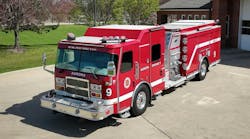As we begin a new year, may this be the year that we operate more safely. Let this year be less deadly for firefighters than 2007. With this in mind, the International Association of Fire Chiefs (IAFC) has announced in a press release that Safety Stand Down Week for 2008 is going to be renamed Fire/EMS Safety, Health and Survival Week, which will be held June 22-28. The week will be devoted to reviewing safety policies, evaluating the progress of existing initiatives, and discussing health and fitness.
I think we take an awful lot for granted in the fire service; for instance, riding safely on apparatus. How many fire departments struggle to get firefighters to buckle their seatbelts and ride safely in apparatus? How many fire departments or training academies train firefighters how to safely mount and ride on apparatus? We take a lot for granted when we assume that everyone knows what is expected of them and follows the rules that are intended to keep them safe.
I recently participated in a meeting that evolved into a discussion about the proper order for donning bunker gear, self-contained breathing apparatus (SCBA) and seatbelts when responding to an alarm. Several apparatus manufacturers were represented at this meeting and they were surprised to learn that many firefighters actually don the SCBA straps before arriving on the fireground. They had never thought about the difficulty of managing both SCBA and seatbelt straps because they didn't think a firefighter would try to deal with both at the same time. They believed that the SCBA straps were donned only after arrival at the fire scene and after the seatbelt and shoulder harness had been released. How would they know? They build fire apparatus -- they don't ride in them.
Does your fire department have a standard practice for getting dressed when responding to a structural fire alarm? Do you train on it? Or is it so elementary that everyone just does it? Before boarding the apparatus, do all firefighters don their boots and bunker pants, then their coats -- or does everyone just scramble into the cab and flail around until they are dressed? And does the driver check to make sure that everyone is seated and belted before moving the apparatus -- or does the rig start rolling while the crew members are standing and trying to get dressed?
After entering the cab, do all firefighters sit in their assigned seats, slip their shoulders into the SCBA straps and then fasten their seatbelts (see Figure 1)? What about their helmets? National Fire Protection Association (NFPA) standards state that firefighter helmets should not be donned when riding inside closed cabs, but secured in the cab within arm's reach of the firefighter. Why not wear the helmet? With high back seats, the back brim on a New Yorker-style helmet could inflict a neck injury during a crash. The helmet should not be worn until the firefighter is outside the rig.
When I was an instructor at the New York State rookie school, I taught students to put their gloves on their laps. After arriving on the scene, the firefighters would disembark, put on their helmets and then put on their gloves. It took a couple of seconds, but firefighters should be looking at the building and doing a quick size-up while putting on their gloves. That couple of seconds might allow the firefighters to identify the location of the fire or note if smoke or flames are evident from the exterior.
How many fire chiefs give out cards for volunteer firefighters to display and operate courtesy lights on their privately owned vehicles (POVs) during a response? How many of those fire chiefs provide training to their firefighters in the proper operation and response of a POV before giving out those cards? Or do we just take a safe response for granted?
How many fire departments train firefighters in the proper operation of apparatus sirens and air horns? Did you know that for a mechanical siren to be most effective, you need to get your foot off the pedal and let the siren cycle back down through the full range of sounds that it can produce? Did you also know that you should switch an electronic siren from the wail to the yelp mode at least 150 feet from an intersection?
I have noticed another problem teaching classes in volunteer fire stations around the country. Why is there no gear laid out next to the apparatus in a state of readiness for a quick response? I once asked a young firefighter where his gear was, and he proudly proclaimed that it was in his gear bag. So I asked, "Where is your gear bag? And he replied that it was out in his pickup truck in the parking lot. My reply was that "out there" is not a very good place for it if he is inside the firehouse.
I asked how many of the firefighters in the class were apparatus drivers? Seven firefighters raised their hands, although I had counted only four fire trucks out in the apparatus bay. So I asked who is assigned to drive each piece of apparatus and the chief replied "no one." I thought to myself, what are they going to do if they get a call? Trip the guy ahead of you, so you can get to the rig first and drive? Or does everyone run to the apparatus driver's door and get into a fistfight to determine who drives? That is not a very efficient way to respond while everyone is in quarters. If the firefighters are already at the fire station training or at a meeting, response times will be greatly improved if the response is organized and riding assignments are set in advance.
A volunteer fire department that I recently instructed uses a white board for listing riding and driving assignments for the apparatus in the station (see figure 2). As firefighters enter the station, they are given riding or driving assignments that were entered onto the white board. The white board was then displayed in the classroom. The firefighters laid out their gear next to the apparatus that they were assigned to ride or drive.
I recently spoke with a police officer friend who told me about the SUV driving course that he just completed as part of his advanced police training. How many fire chiefs who are driving around in SUVs have had any specialized training for these very special, easy-to-rollover response vehicles? There are actually several places around the country that offer SUV driver training -- one such place is in my home state of New York.
I hope that these random thoughts will spur you and your department to train for a safer 2008.
MICHAEL WILBUR, a Firehouse® contributing editor, is a lieutenant in the New York City Fire Department, assigned to Ladder Company 27 in the Bronx, and has served on the FDNY Apparatus Purchasing Committee. He consults on a variety of apparatus-related issues around the country. For further information, access his website at www.emergencyvehicleresponse.com.





